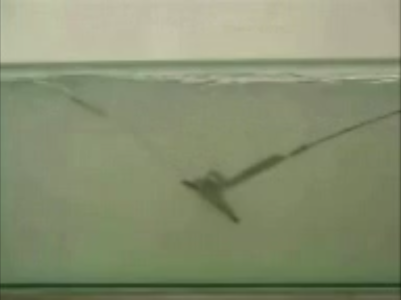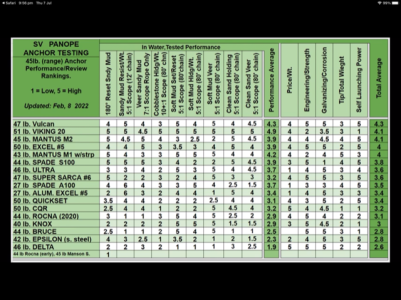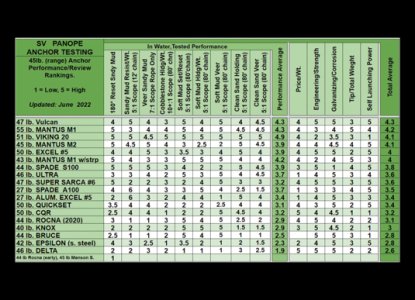Neeves
Well-Known Member
Most good modern anchors of 15kg in the 2006 YM anchor test held around 2t in clean sand. A 15kg anchor would be adequate for a 35' modern yacht. If the expectation is that a 15kg anchor will be inadequate and the tension in the rode higher than 2t then the implications should be explored. Commonly a 35' yacht would be equiped with a 8mm G30 chain and it would wise to assume that at a tension of 1,500kg the chain will deform, stretch, and would then no longer fit the gypsy. Thus if the tension in the rode is expected to be 1,500kg or greater a further recommendation is needed to not only upsize the anchor but also use bigger, or better, chain and either buy a new gypsy or a new windlass.
The chain suddenly becomes the weak link.
I have measured rode tensions and terminated my testing at 35 knots when rode tensions I recorded were peaking at 650kg. I was not using a snubber - I was simply trying to identify tensions in the rode. 650kg tensions are scary, you fear not that the anchor will break free, and drag, but that something will break. The anchor did not drag - but when I became sufficiently concerned about yacht integrity and came to lift the anchor, a 15kg Anchor Right Excel (described by some as a plough type design) - it was buried almost irretrievably - it had simply dived more deeply - no suggestion of dragging.
35 knots is not particularly strong but I had no snubber and was working at short scope. The 'ride' would have been much more comfortable with a snubber. But if this had not been an exercise in the collation of data I would have terminated the experiment much earlier and moved location.
I can assure you 650kg of tension is scary, grounds for divorce - but the 15kg anchor was not the weak link - the crew, me, were the weak link. You would need some pretty strong reason not to move under those conditions. Consequently the idea of needing an anchor with a hold greater than that of a 15kg Excel for a 35' yacht is the stuff of fiction - a Stephen King horror story - not reality.
As I mention 35 knots is not particularly unusual (and weather forecasts and a sensible choice of anchorage commonly ensures owners are not subject to same). But life is not predictable so we must prepare and more sensible preparation is use of, long, snubbers, use of a decent length of rode, and not a scope of 3:1 (unless using good snubbers). Other options to consider would be deploying 2 anchors in a fork (NOT to increase hold but to manage veering).
Interestingly when we have been subject to 35knots and the bridle (2 x snubbers) are managing the tension (same conditions as the test 35 knot test, above) it is quite possible to hold, secure, one arm of the bridle tension by hand. The 650kg snatch loads are converted to less than 50kg.
You don't need a bigger anchor, you need a snubber (or bridle) or decent catenary (which would mean a deep anchorage).
Jonathan
The chain suddenly becomes the weak link.
I have measured rode tensions and terminated my testing at 35 knots when rode tensions I recorded were peaking at 650kg. I was not using a snubber - I was simply trying to identify tensions in the rode. 650kg tensions are scary, you fear not that the anchor will break free, and drag, but that something will break. The anchor did not drag - but when I became sufficiently concerned about yacht integrity and came to lift the anchor, a 15kg Anchor Right Excel (described by some as a plough type design) - it was buried almost irretrievably - it had simply dived more deeply - no suggestion of dragging.
35 knots is not particularly strong but I had no snubber and was working at short scope. The 'ride' would have been much more comfortable with a snubber. But if this had not been an exercise in the collation of data I would have terminated the experiment much earlier and moved location.
I can assure you 650kg of tension is scary, grounds for divorce - but the 15kg anchor was not the weak link - the crew, me, were the weak link. You would need some pretty strong reason not to move under those conditions. Consequently the idea of needing an anchor with a hold greater than that of a 15kg Excel for a 35' yacht is the stuff of fiction - a Stephen King horror story - not reality.
As I mention 35 knots is not particularly unusual (and weather forecasts and a sensible choice of anchorage commonly ensures owners are not subject to same). But life is not predictable so we must prepare and more sensible preparation is use of, long, snubbers, use of a decent length of rode, and not a scope of 3:1 (unless using good snubbers). Other options to consider would be deploying 2 anchors in a fork (NOT to increase hold but to manage veering).
Interestingly when we have been subject to 35knots and the bridle (2 x snubbers) are managing the tension (same conditions as the test 35 knot test, above) it is quite possible to hold, secure, one arm of the bridle tension by hand. The 650kg snatch loads are converted to less than 50kg.
You don't need a bigger anchor, you need a snubber (or bridle) or decent catenary (which would mean a deep anchorage).
Jonathan



